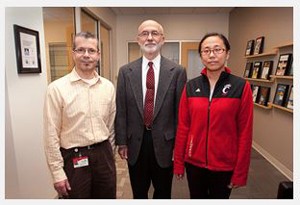
2014 Innovation Award Series: Steckl and Pauletti Prototype POC Diagnostic Testing Device
Andrew J. Steckl, professor in the University of Cincinnati's College of Engineering and Applied Science
Department of Electrical Engineering and Computing Systems,
and Giovanni Pauletti
,
associate professor at the
UC James L. Winkle College of Pharmacy
, recently prototyped a low-cost, paper-based microfluidics diagnostic device which will allow patients to adequately self-monitor their oral anticoagulation therapy.
Anticoagulants are drug molecules that interfere with normal blood clotting in order to prevent and treat potentially deadly blood clots. Doctors prescribe anticoagulants to patients to manage serious cardiovascular diseases such as venous thromboembolism, systemic embolism, and atrial fibrillation that can cause a stroke.
Since anticoagulation drugs like warfarin make the blood "thinner" to prevent the formation of blood clots, the effectiveness of anticoagulants must be regularly monitored in order to avoid excessive bleeding, a complication that could offset any benefits. Usually, less than 50 percent of all patients are properly adjusted within the desired efficacy range. These patients are required to visit trained professionals to receive anticoagulation measurements in a hospital or lab setting that meets the federal regulatory requirements.
Recently, the United States Food and Drug Administration (FDA) granted the use of portable point-of-care (POC) anticoagulation monitoring devices with the objective to improve clinical management of patients on oral anticoagulation therapy. Annual expenses associated with current commercial POC anticoagulation self-testing devices are expensive as they range between $3,000-4,000, including the purchase of the required optical reader.
The diagnostic testing device proposed by Steckl and Pauletti is made out of ultra-low-cost paper and does not require a battery-operated optical reader. Steckl predicts that successful implementation of the technology will allow patients adequate, rapid, self-monitoring of oral anticoagulation therapy at a fraction of the current cost. As opposed to monthly visits to the doctor at a hospital, the portable POC testing devices offer the advantage of convenient weekly monitoring of patients in anticoagulation clinics, nursing homes, physicians offices, or a patients home (self-testing).

Steckl and Pauletti's POC diagnostic testing device
Steckl and Paulettis paper-based microfluidic portable testing device comes in a diagnostic test kit. A small, oval cut-out in the plastic holder of the kit allows a small blood drop to be obtained after a fingerstick is applied. A rectangular window facilitates real-time visual monitoring of test progress on the paper strip that is completed within four minutes. The distance traveled by red blood cells on the paper strip depends on the overall viscosity, or consistency (the state of being thick, sticky, etc.), of the blood sample which is controlled by coagulation factors. Anticoagulants decrease blood viscosity and allow red blood cells to travel further on the paper strip within the same time.
Paper-based microfluidics create simple analytical devices that are easy to use anywhere and have inherently very low manufacturing costs. Steckl predicts that the combination of low-cost materials and the ability to efficiently mass produce very large quantities of this diagnostic test using advanced roll-to-roll printing press technology will translate into a very low cost of goods sold.
To date, the
Bill & Melinda Gates Foundation
has awarded Steckl and Pauletti a Grand Challenges Explorations Round 10 grant which has allowed the researchers to successfully create a prototype of their experimental paper-based microfluidics device. They are currently testing the device using animal blood samples. After successful clinical validation, commercialization will be possible within a year or so.
For more information about the UC College of Engineering and Applied Science, please visit:
Additional Contacts
Related Stories
Mayor Pureval, Rob Richardson lead ethical AI symposium
July 5, 2024
As artificial intelligence rapidly integrates into everyday life, Rob Richardson, CEO and founder of Disrupt Now and MidwestCon and local tech startup partner of the University of Cincinnati 1819 Innovation Hub, recently spearheaded the Responsible AI Symposium with Cincinnati Mayor Aftab Pureval, calling upon community leaders to discuss and ensure artificial intelligence technologies help users rather than harm.
UC’s microchip training includes innovative VR
July 2, 2024
To build a virtual microchip factory, University of Cincinnati doctoral students turned to the real one where they work. UC launched a new training program for microchip manufacturing in advance of the new fabrication plant Intel Corp. is opening in Ohio.
Put down that beer; it's not a tanning lotion
July 1, 2024
The University of Cincinnati's Kelly Dobos joined WVXU's Cincinnati Edition to discuss what's fact and what's myth when it comes to sunscreen use, different kinds of sunscreen and a social media recommendation to use beer on your skin to help get a tan.
